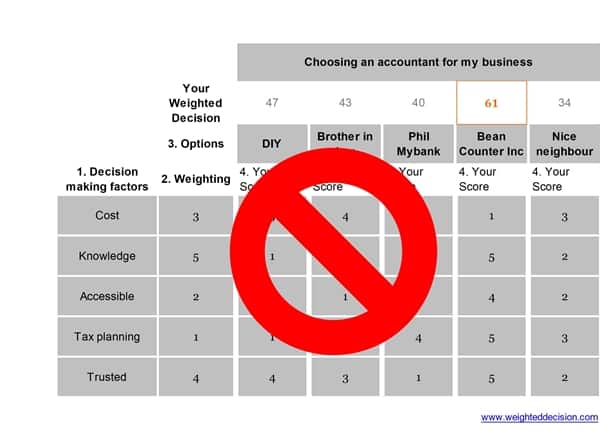What are the weaknesses of a Weighted Decision Matrix?
The weaknesses of a weighted decision matrix include criticisms of how the options and factors involved are arbitrary or incomplete; how it can suffer from bias and that scoring methods can be manipulated. It is important to understand these limitations when using the tool to make an important decision.
- When listing all the options to choose between there is no way of knowing whether there are any missing without having to consult widely and every eventuality considered. No-one can know everything and important options can be left out without realising.
- It is also possible to mislead others by deliberately presenting the weighted decision matrix as a scientific approach to a problem with no equal, and then leaving out options to be considered either on purpose or through personal bias.
- The list of criteria can be extended to include many factors that are related to each other or have limited impact on the decision to be made. In totality, these can add up to be as important or even more so than the most important factors leading to an inaccurate decision.
- A weighting mechanism that gives accurate relative weighting to all factors involved is difficult and often a subjective process. Giving a value from one to five to five different factors will not weight the most important factor correctly if it is of much more importance relatively. A scoring method to reflect this must be worked out e.g. scores of 1,2,3,4 and 10 may be more accurate.
- An objective approach to scoring using quantitative measurements is difficult to achieve in many scenarios and often overlooked entirely.
- A team approach to scoring can result in averages being used or the loudest voice listened to. Again, this is still a subjective approach.
- Ruling out options that have scored poorly overall can result in missing out on strengths they have on one or two factors. Opportunities to improve the winner against these factors by learning from the losers can be missed if they are dismissed too quickly.
- If an option completely fails against one factor, it needs to be ruled out as a possible winner early in the process or time could be wasted trying to make it work by others not aware of the failure against a Go/No Go criteria.
Whilst you’ll appreciate we love our weighted decision matrix template as a simple yet effective decision making tool, it is fair to say that it does have its weaknesses. If you’d like to know more and you’re feeling academic then there is an excellent paper written by Douglas Hubbard and Dylan Evans.


